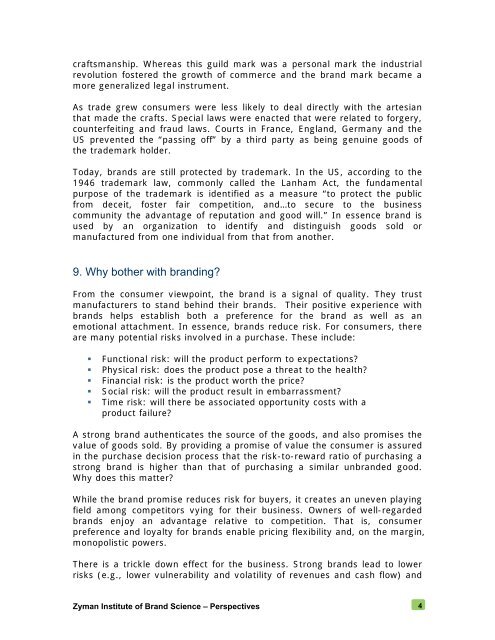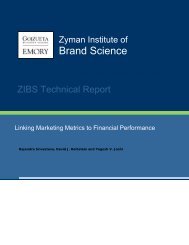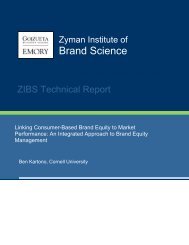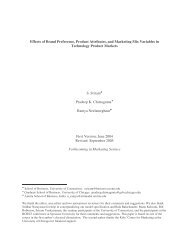The Executive's Guide to Branding - Emory Marketing Institute
The Executive's Guide to Branding - Emory Marketing Institute
The Executive's Guide to Branding - Emory Marketing Institute
You also want an ePaper? Increase the reach of your titles
YUMPU automatically turns print PDFs into web optimized ePapers that Google loves.
craftsmanship. Whereas this guild mark was a personal mark the industrial<br />
revolution fostered the growth of commerce and the brand mark became a<br />
more generalized legal instrument.<br />
As trade grew consumers were less likely <strong>to</strong> deal directly with the artesian<br />
that made the crafts. Special laws were enacted that were related <strong>to</strong> forgery,<br />
counterfeiting and fraud laws. Courts in France, England, Germany and the<br />
US prevented the “passing off” by a third party as being genuine goods of<br />
the trademark holder.<br />
Today, brands are still protected by trademark. In the US, according <strong>to</strong> the<br />
1946 trademark law, commonly called the Lanham Act, the fundamental<br />
purpose of the trademark is identified as a measure “<strong>to</strong> protect the public<br />
from deceit, foster fair competition, and…<strong>to</strong> secure <strong>to</strong> the business<br />
community the advantage of reputation and good will.” In essence brand is<br />
used by an organization <strong>to</strong> identify and distinguish goods sold or<br />
manufactured from one individual from that from another.<br />
9. Why bother with branding?<br />
From the consumer viewpoint, the brand is a signal of quality. <strong>The</strong>y trust<br />
manufacturers <strong>to</strong> stand behind their brands. <strong>The</strong>ir positive experience with<br />
brands helps establish both a preference for the brand as well as an<br />
emotional attachment. In essence, brands reduce risk. For consumers, there<br />
are many potential risks involved in a purchase. <strong>The</strong>se include:<br />
• Functional risk: will the product perform <strong>to</strong> expectations?<br />
• Physical risk: does the product pose a threat <strong>to</strong> the health?<br />
• Financial risk: is the product worth the price?<br />
• Social risk: will the product result in embarrassment?<br />
• Time risk: will there be associated opportunity costs with a<br />
product failure?<br />
A strong brand authenticates the source of the goods, and also promises the<br />
value of goods sold. By providing a promise of value the consumer is assured<br />
in the purchase decision process that the risk-<strong>to</strong>-reward ratio of purchasing a<br />
strong brand is higher than that of purchasing a similar unbranded good.<br />
Why does this matter?<br />
While the brand promise reduces risk for buyers, it creates an uneven playing<br />
field among competi<strong>to</strong>rs vying for their business. Owners of well-regarded<br />
brands enjoy an advantage relative <strong>to</strong> competition. That is, consumer<br />
preference and loyalty for brands enable pricing flexibility and, on the margin,<br />
monopolistic powers.<br />
<strong>The</strong>re is a trickle down effect for the business. Strong brands lead <strong>to</strong> lower<br />
risks (e.g., lower vulnerability and volatility of revenues and cash flow) and<br />
Zyman <strong>Institute</strong> of Brand Science – Perspectives 4





